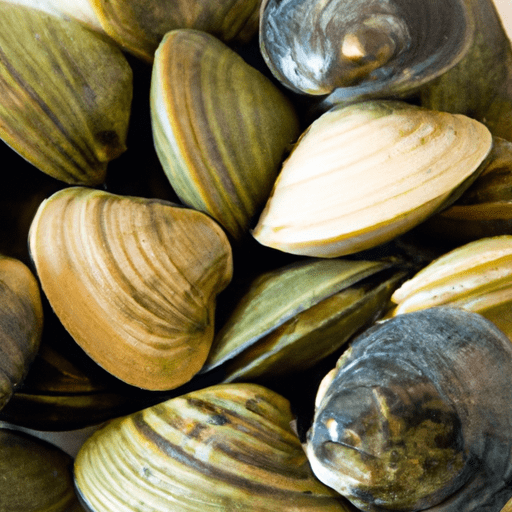Filled with Flavor: Exploring the World of Clams
If you’re a seafood lover, then chances are you’ve indulged in the delicious and versatile world of clams. These remarkable bivalves, found in both freshwater and saltwater habitats, have been an integral part of culinary traditions across the globe for centuries. In this blog post, we’ll dive into the captivating world of clams, uncovering their unique taste profile, exploring their common uses in cooking, delving into their nutritional value, and unearthing some fascinating history and facts.
A Taste of the Sea
Clams possess a distinct briny and oceanic flavor that sets them apart from other shellfish. Their taste can be described as delicate, sweet, and slightly mineral-like. The flavor varies across different species of clams, ranging from mild and subtly sweet notes to a rich, buttery taste. This versatility makes clams a beloved ingredient in numerous cuisines worldwide.
Cooking with Clams
Clams can be cooked in a plethora of enticing ways that showcase their natural flavors. From classic recipes to innovative culinary creations, the options are endless. Here are some popular cooking methods and dishes that highlight the versatility of clams:
Steamed Clams in a Fragrant Broth
Steaming clams in a flavorful broth is a simple yet impressive way to enjoy their natural succulence. Infused with aromatic herbs, garlic, white wine, or broth, this method retains the briny essence of the clams while imparting a delightful depth of flavor. Serve them with crusty bread to soak up the heavenly juices, and you have a satisfying and comforting dish suitable for any occasion.
Clam Chowder: A Bowl of Comfort
Clam chowder, a creamy soup filled with tender clams, potatoes, onions, and bacon, is an all-time favorite in seafood-loving communities. Originating from coastal regions, particularly New England in the United States, this comforting dish warms the heart and tempts the taste buds. Whether you prefer a creamy white chowder or a tomato-based Manhattan clam chowder, the harmonious blend of flavors will leave you craving more.
Spaghetti alle Vongole: A Taste of Italy
Italy’s culinary delight, spaghetti alle vongole, showcases clams in a simple yet luxurious pasta dish. The marriage of al dente spaghetti, succulent clams, garlic, white wine, chili flakes, and parsley creates a symphony of flavors that transports you to the shores of the Mediterranean. This dish beautifully combines the freshness of the clams with the simplicity and elegance of Italian cuisine.
Nutritional Value
Not only are clams delectable, but they also bring a wealth of nutritional benefits to the table. Rich in high-quality protein, clams provide the body with essential amino acids necessary for building and repairing tissues. They are also a fantastic source of vitamins and minerals, including vitamin B12, iron, selenium, and omega-3 fatty acids. These nutrients contribute to maintaining a healthy metabolism, boosting brain function, and supporting cardiovascular health.
Unearthing Interesting Facts
Beyond their culinary prowess, clams have a fascinating history and some intriguing facts worth exploring:
- Did you know that clams have been consumed since prehistoric times? Archaeological evidence suggests that clams were a significant part of the diet of our ancient ancestors.
- The world’s largest clam species is the giant clam, which can grow up to 4 feet in length and weigh up to 500 pounds. These majestic creatures are protected in many areas due to their endangered status.
- Clams have an incredible lifespan. While some species live for a few decades, others, like the ocean quahog, can live up to an astonishing 400 years.
- Certain types of clams, like geoducks, have impressive long necks, which can extend several feet below the ocean floor. These unique clams are highly prized for their tender meat and are considered a delicacy in many Asian cuisines.
Conclusion
Clams, with their distinctive taste and culinary flexibility, continue to captivate food lovers around the world. Whether enjoyed steamed, added to hearty chowders, or incorporated into pasta dishes, these bivalves offer a delightful culinary adventure. Moreover, their nutritional value and intriguing history only add to their allure. So, why not embark on your own clam-cooking journey and savor the ocean’s bounty?
Clams
Origin: Clams are a type of bivalve mollusk found in both saltwater and freshwater environments around the world. They have been harvested and consumed by humans for thousands of years. Clams are found in various coastal regions and are a popular seafood ingredient in many cuisines worldwide.
Common Uses: Clams are commonly used in various dishes, including soups, stews, pastas, chowders, and clam bakes. They can be enjoyed steamed, grilled, fried, or baked. Clam meat is also used to make clam sauce and clam chowder. The shells of clams are sometimes used as serving vessels or for decorative purposes.
Nutritional Benefits: Clams are highly nutritious and offer several health benefits. They are a good source of protein, vitamins (such as vitamin B12), minerals (including iron and selenium), and Omega-3 fatty acids. They also contain a range of other nutrients, including magnesium, potassium, and zinc.
Unique Properties and Historical Significance: One unique property of clams is their ability to create pearls. While this is more commonly associated with oysters, certain types of clams can also produce pearls. These pearls, known as “clam pearls” or “quahog pearls,” are generally small and not as valuable or widely known as traditional pearls.
Historical significance: Clams have been an important food source throughout history. Native American tribes on the East Coast of North America, such as the Wampanoag and Narragansett, relied heavily on clams as part of their diet. Clams were also a significant staple for many coastal communities, such as those in New England. The clamming industry has played a significant role in local economies, trade, and cuisine in many coastal regions around the world.




Use the share button below if you liked it.
It makes me smile, when I see it.